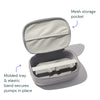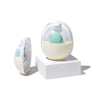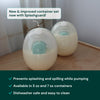Picture this: a stress-free, tear-free afternoon full of snuggling and breastfeeding your precious newborn. If you're struggling to achieve the perfect latch, this vision may feel far from reality. The truth is, breastfeeding can be difficult, and incredibly frustrating!
While this is the case, know that every breastfeeding journey is unique and special. If your baby is taking longer to latch, that does not mean there is anything wrong with you or your little one. Sometimes it takes more time for mamas to find that magic "thing" that makes your baby latch.
In this blog, we cover the top latching tips for frustrated new moms. Keep reading to learn which boxes should be checked as you begin breastfeeding. We believe in you, mama!
1. Encourage Your Baby to Open Their Mouth
If your little one is hesitant to open their mouth, you can gently brush their lips against the nipple to encourage them to open wider.
While babies can't understand the mechanics of milk production, they do have special instincts that help them find their mama's breast milk. Because of this, a baby that is reluctant to open their mouth is not a cause for concern. Instead, it may simply mean they need another signal that their mama is ready to breastfeed. Skin-to-skin contact and holding them near your breasts are other alternatives for coaxing them to feed.
2. Find a Breastfeeding Position That Works
Finding a breastfeeding position that is effective and comfortable for both you and your baby takes some practice. As you practice latching with your baby, you may use a different position than one you use later on in your breastfeeding journey.
In the early weeks of breastfeeding, the laid-back position is a popular choice for mama's who want to encourage their baby to follow their instincts.
This position allows you to recline while laying your baby across your chest. Hold your baby close to your breast so that they can easily find the nipple. Over time you may opt for a more upright position, but laying back will allow your baby to naturally find your breasts and learn to breastfeed.
3. Hold Your Baby Close to Your Breast
While newborns have those magical instincts to seek out their mama's breast milk, they may need some hints when they're learning to feed. Did you know your baby can also smell and recognize your breast milk? In fact, the smell of a mother's breast milk can have a significant calming effect on babies! Bringing your little one closer to your breast can signal to them that it's time to latch.
4. Ensure Your Baby Has Proper Chin Position
Your baby's mouth should be positioned so that their chin touches your breast with their head tipped slightly back. This position allows their nose to be unobstructed from breathing, and their tongue to effectively reach your breast. If your baby's nose touches your breast before their chin, they are likely not in the most efficient position for latching.
5. Create Skin-to-Skin Contact
Studies show that skin-to-skin contact between mama and baby helps initiate early breastfeeding. Skin-to-skin contact can also help to regulate your baby's breathing, temperature, digestion, and is also relaxing. Who knew there were so many benefits to baby cuddles!
6. Don't Force Anything
As you encourage your baby to breastfeed, remember not to force anything that feels uncomfortable or isn't working. Finding the perfect latch takes time, and you will get it eventually! If something feels painful or unusual as you help your baby find your breast, gently detach them and try again. Some pain and discomfort is normal on the first few latches, but over time it should feel like a gentle tug.
Remember to listen to your baby as you learn to breastfeed. If your baby is not hungry, they may not seem as interested in feeding. Practice breastfeeding when your baby is showing signs of hunger to encourage them to latch.
7. Find a Relaxing Space
Breastfeeding doesn't have to be a stressful experience, but we know it can feel that way at first. To eliminate some of the stress you can control, find a quiet and comfortable space to breastfeed. Make sure you have everything you need within arm's reach. Water, pillows, blankets, and a good show or book are all helpful for settling in while you work with your baby on latching.
8. Check in With Yourself
If you and your baby are experiencing problems latching, know that it is not your fault. Finding that perfect connection takes practice and time. If you feel frustrated after trying several times, take a break and come back later to give it a shot.
9. Don't Be Afraid to Ask for Help
You are not alone in your breastfeeding journey. If you are feeling stuck, there are professionals, friends, and family here to help. Finding a deep latch can solve many common breastfeeding issues, so don't hesitate to ask for support.
You are a superhero mama. Be patient with your baby, and most importantly, yourself. To find more information on breastfeeding and pumping, visit the Willow blog. From advice on exclusive pumping schedules to FAQs answered by lactation consultants, we want to help you on every step of your breastfeeding journey.
Get pumping support with Simplifed
Get pumping support with Simplifed
Get access to free virtual feeding support from the lactation consultants at Simplifed. They can help you navigate supply issues, introduce a bottle, and more, and are trained on Willow pumps.

























